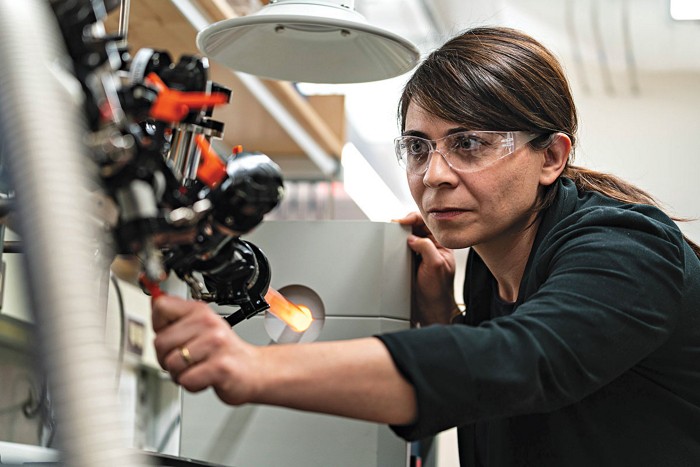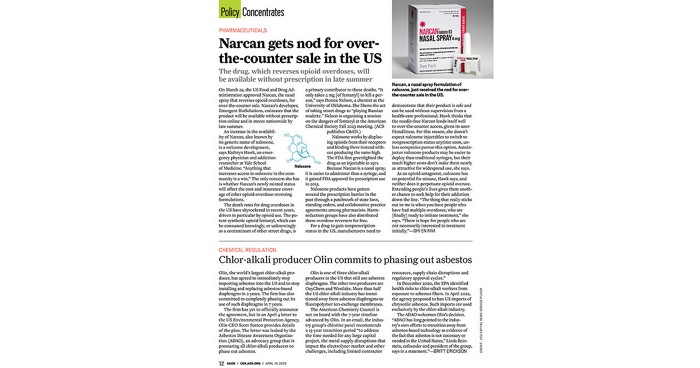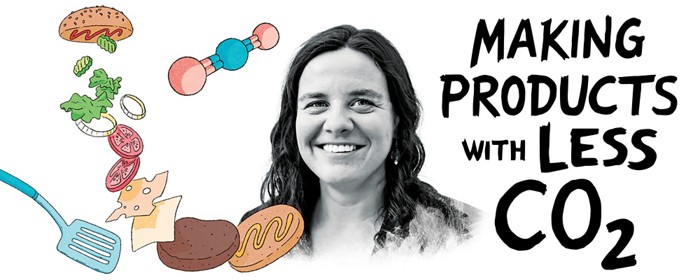Advertisement
Grab your lab coat. Let's get started
Welcome!
Welcome!
Create an account below to get 6 C&EN articles per month, receive newsletters and more - all free.
It seems this is your first time logging in online. Please enter the following information to continue.
As an ACS member you automatically get access to this site. All we need is few more details to create your reading experience.
Not you? Sign in with a different account.
Not you? Sign in with a different account.
ERROR 1
ERROR 1
ERROR 2
ERROR 2
ERROR 2
ERROR 2
ERROR 2
Password and Confirm password must match.
If you have an ACS member number, please enter it here so we can link this account to your membership. (optional)
ERROR 2
ACS values your privacy. By submitting your information, you are gaining access to C&EN and subscribing to our weekly newsletter. We use the information you provide to make your reading experience better, and we will never sell your data to third party members.
Climate Change
It’s time to talk about methane removal
The potent greenhouse gas cannot be captured like carbon dioxide, so scientists are developing strategies to destroy it
by Prachi Patel
February 14, 2024
| A version of this story appeared in
Volume 102, Issue 4

A long metal box hooked to a jumble of hoses, gauges, and measuring instruments sits in a laboratory at the University of Copenhagen’s Chemistry Department. Inside, at one end, ultraviolet light-emitting diodes glow an eerie purple. This reaction chamber has been built to destroy methane using UV light and chlorine. If installed in livestock barns, a larger version of this device could keep thousands of metric tons of the greenhouse gas from reaching the atmosphere, says Matthew Johnson, the chemistry professor leading the work.
Johnson is also cofounder and CEO of the start-up Ambient Carbon. The company plans to commercialize the technology to eradicate methane emissions from farms, wastewater treatment plants, and biogas plants, all of which release the greenhouse gas at concentrations too low to burn off. Three-quarters of all methane sources, in fact, emit the gas at low concentrations—under 1,000 ppm—Johnson says. “Today, there are no efficient solutions on the market. And that’s the gap we address with this technology.”
Efforts to curb global warming have mostly focused on carbon dioxide. Methane has long been the elephant in the climate conference room, even though it traps over 80 times as much heat as CO2 does over a 20-year period, according to the United Nations Environment Programme.
Human-driven methane emissions—mostly from agriculture and fossil fuel activities—have pushed global temperatures up by 0.5 °C above preindustrial levels. That’s close to the 0.8 °C contribution from CO2, even though methane is present in the atmosphere at a mere 2 ppm, compared with CO2 ’s 420 ppm, and lasts for just about a decade rather than centuries. Plus, unlike CO2 emissions, which are slowing, methane emissions are accelerating as a warmer, wetter world triggers more methane release from tropical wetlands and melting permafrost.
In recent years, methane has begun to draw more attention. Over 150 countries signed the Global Methane Pledge, launched at the 2021 Conference of the Parties to the United Nations Framework Convention on Climate Change (COP26) by the US and the European Union. The goal is to reduce human methane emissions by 30% by 2030, mostly via fixing leaks from oil and gas operations.
But climate scientists say we need to do more. Removing methane emissions from the air could be the fastest way to cool the planet in the short term and will be critical to meeting climate goals, they say. “Methane is the blowtorch that is adding to the slow simmer of global warming,” says Gabrielle Dreyfus, chief scientist at the Institute for Governance and Sustainable Development (IGSD). “Reducing methane is essentially turning down that blowtorch.”
A small number of chemists and engineers are now developing technologies to do that. And some, like Johnson, are getting ready to embark from the lab.
Destruction by oxidation
In terms of reducing emissions, CO2 has a 50-year head start on methane. Dozens of carbon capture plants operate around the world, grabbing CO2 from gas mixtures using materials and methods that scientists have honed over decades.
Not only has methane reduction technology been slow out of the gate, but methane is a more elusive, complicated beast than CO2. Besides its low atmospheric concentration, methane is relatively inert, and the molecule is similar in size to nitrogen, which is far more abundant. Those factors make it hard to grab methane using chemical or size-based approaches, says Christopher Jones, a chemical engineer and carbon capture expert at the Georgia Institute of Technology. “There’s much more CO2, and it’s easier to grab. If direct air capture of CO2 is in the late-adolescent-to-tween stage, methane removal is an infant.”

Yet every baby step in methane removal is critical, given its outsize impact, says Desirée Plata, an oceanographer and professor of civil and environmental engineering at the Massachusetts Institute of Technology. Plata has devised a way to destroy methane using aluminosilicate minerals, or zeolites, as catalysts. Because methane is hard to trap, her team uses the catalysts to oxidize it and turn it into CO2. Methane naturally becomes CO2 in the atmosphere after a decade or so, she says. “We’re accelerating that process to undercut methane’s global warming power. If you convert about half of [atmospheric] methane to CO2, it saves about 16% of global warming over the next 100 years.”
Plata’s oceanography background led her to find inspiration from methanotrophic bacteria that use copper-containing proteins to oxidize methane. Her team makes zeolites with nanoscopic pores that mimic the methane-trapping pockets in bacterial proteins and then dopes the zeolites with copper. “The zeolites are stable in air and really cheap,” she says. “They can be made for under a dollar per kilogram. And the synthesis is super easy. High school and undergraduate college students make the material in our lab.”
Laboratory tests show that the catalysts can grab and oxidize methane at atmospheric concentrations. But the process requires temperatures of 300 °C (ACS Environ. Au 2021, DOI: 10.1021/acsenvironau.1c00034). In a recent paper, researchers at Stanford University concluded that for the economic benefit of such a heated reactor for methane removal to outweigh its energy cost, it must operate at no higher than 3 °C above ambient temperature (Environ. Res. Lett. 2023, DOI: 10.1088/1748-9326/acf603).
The MIT team is trying to drive down the working temperature by tweaking the catalyst materials. But the technology already makes sense for coal mines, Plata says. Conversion of methane to CO2 is an exothermic reaction, and methane concentrations are high enough in mines for the generated heat to be fed back into the reactor, making it self-sustaining. The system could be installed in mine ventilation shafts, she says. “If you could apply it in 30% of coal mining, you would instantaneously stop the accumulation of methane in the atmosphere. We should be going after that low-hanging fruit.”
Plata has cofounded a start-up, Moxair, and her team is now building a 1:100-scale prototype of a full-scale modular reactor, which will eventually handle about 2,800 m3 of air per minute. The researchers plan to test the prototype near Boston this year and then test a full-scale reactor at a coal mine by 2027. “Technology 2.0” for dairy barns, where methane concentrations are much lower, will come later, she says.
Others are finessing various oxidative destruction techniques. At Stanford University, nanotechnologist Matteo Cargnello and team are working on palladium catalysts that function at temperatures as low as 150 °C (Acc. Chem. Res. 2023, DOI: 10.1021/acs.accounts.3c00454). But palladium is expensive. So chemical engineer Mary Lidstrom of the University of Washington and her colleagues are bypassing costly metals and turning to bacteria. The group recently identified a strain of methanotrophic bacteria that devour methane at relatively low concentrations of 200–1,000 ppm. The researchers plan to genetically modify the bacteria so they can oxidize methane faster at 500 ppm.
Methane by the numbers
▸ 12 years: Atmospheric lifetime of methane
▸ 84: The factor by which methane is more effective than carbon dioxide at trapping heat over 20 years
▸ 1,620 and 1,910 ppb: Atmospheric CH4 concentrations in 1983 and 2022, respectively
▸ 30%: Share of global temperature rise from CH4 emissions since the onset of the Industrial Revolution
▸ 580 million metric tons: Global CH4 emissions in 2023
▸ 60%: Portion of those emissions from human-driven activity
Sources: NASA, United Nations Environment Programme, International Energy Agency, US National Oceanic and Atmospheric Administration.
Opportunities and risks
The University of Copenhagen’s Johnson is taking an altogether different approach. Instead of using zeolites, catalytic metals, or bacteria, he and his team use UV light to turn chlorine gas into chlorine radicals, which strip hydrogen atoms from methane molecules to produce methyl radicals and hydrogen chloride. The methyl radicals react further with oxygen in the atmosphere, triggering a chain of reactions that produces carbon monoxide and CO2. And the team scrubs the hydrogen chloride from the air stream and uses electrolysis to convert it back to chlorine for reuse.
In December, the team reported results of lab testing at various methane and chlorine concentrations and light intensities (Environ. Res. Lett. 2023, DOI: 10.1088/1748-9326/ad0e33). Since publishing the study, the researchers have upped the methane removal efficiency of their system from 58% to 90%. “It really is a dream come true with the efficiency,” Johnson says.
Now they plan to construct a full-size reactor in a newly purchased shipping container. Johnson says they will test the reactor this summer in the ventilation system of a livestock barn. The site is a farm owned by Arla Foods, the largest dairy cooperative in northern Europe and a supporter of Ambient Carbon’s research. With further engineering improvements, the partners hope to lower energy use so the methane removal system adds minimal cost for dairy farmers while giving them a climate-friendly product. “We think that low-carbon milk could be selling for roughly an additional 30 cents per liter,” Johnson says.
A few start-ups, including Blue Dot Change in the US and AMR in Switzerland, are working on a more out-of-the-box approach that has stirred controversy. Called the iron salt aerosol approach, it involves using towers or ship exhaust to spray iron-based particles over the ocean surface, where they would react with chloride salts in sea spray, creating reactive chlorine radicals that oxidize methane.
Johnson and a team of scientists from Cornell University and the Blas Cabrera Institute of Physical Chemistry recently evaluated what would happen if chlorine were intentionally released into the atmosphere to remove methane emissions (Nat. Commun. 2023, DOI: 10.1038/s41467-023-39794-7). They found that doing so would have the dual climate benefit of cutting methane and ground-level ozone concentrations. That’s because methane drives the photochemical process that creates ozone, and chlorine also reacts with and destroys ozone.
“Releasing chlorine doubles the cooling effect,” Johnson says. “We’re not suggesting that it should be done; we’re just saying, ‘If you did it, this is what would happen.’ ”
There could be unintended consequences depending on atmospheric ozone levels, the team found. Ozone reacts to form hydroxyl radicals that remove methane, so adding too little chlorine can backfire. Chlorine attacks ozone before methane, bringing down hydroxyl concentration, Johnson says, and you can end up increasing the lifetime of methane in the atmosphere. But when ozone levels are low, chlorine “can get right to work removing methane for maximum effect,” he says. “So you definitely need to know what you’re doing.”
The IGSD’s Dreyfus says that any open-air geoengineering approach warrants extra caution. “Certain interventions have greater potential of unintended consequences than others.”
Eventually, implementing any of these methane removal approaches will depend on political will and financing. Coal miners and dairy farmers aren’t making money on methane removal, Plata says. “Somebody has to be creative about how we’re going to finance this.”
But Dreyfus says it’s simply too soon to talk about markets or to implement any strategy on a large scale. She is chair of a National Academies of Sciences, Engineering, and Medicine committee that is conducting a comprehensive study of methane removal approaches, potential risks and benefits, and needed research. Methane removal is “really a novel, emerging field,” she says. “The concept is new, and there are not a lot of people who have been thinking about it. There’s still a lot of work needed to answer fundamental questions on the research front and get more people involved.”
CORRECTION:
This story was updated on Feb. 9, 2024, to correctly convey climate scientist Gabrielle Dreyfus’ intent. In the blowtorch analogy for methane, she meant that reducing methane emissions, and not methane removal technologies specifically, would be akin to turning down the methane blowtorch.





Join the conversation
Contact the reporter
Submit a Letter to the Editor for publication
Engage with us on Twitter